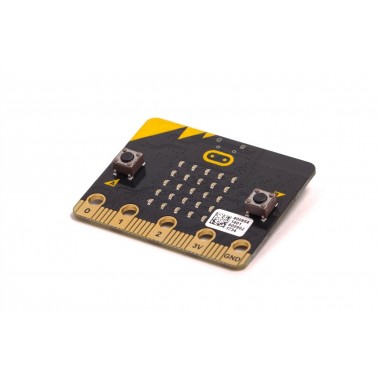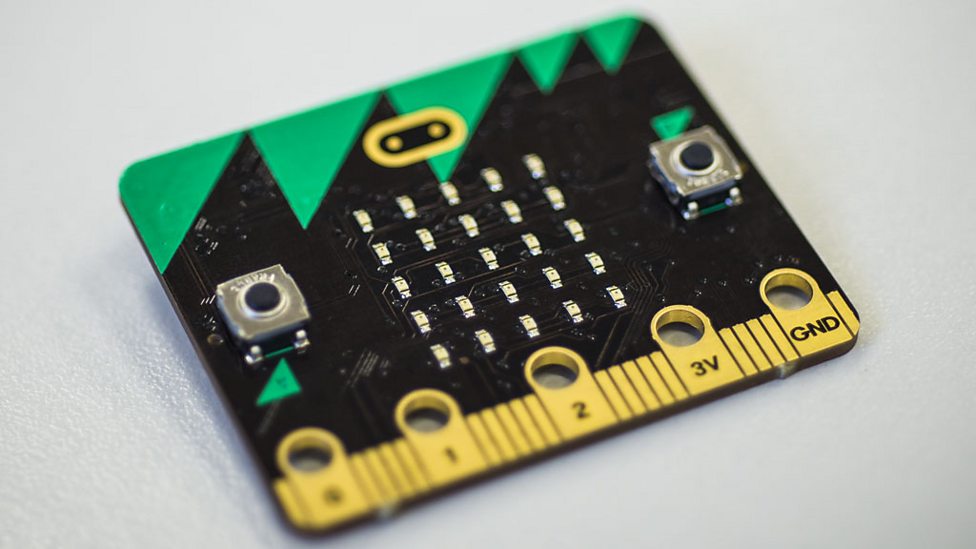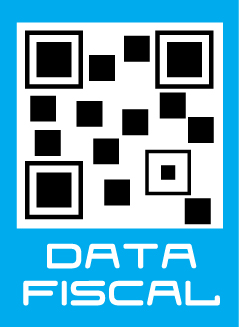Productos
BBC Micro:bit Pocket-Sized Computer for Begginers to Learn Programming

Placa de desarrollo Micro:bit. Integra 3 I/O digitales/Analógicas, Pulsadores, Matriz de 25 leds, Magnetómetro, Acelerómetro, conector para Bateria, interfaz USB y funcionalidad Bluetooth!. Muy fácil de programar con PC en modo online, sin compilador. Apto para ser utilizado por Hobbistas, estudiantes de escuelas de nivel Primario, Secundario, etc. Sus aplicaciones abarcan desde Robots hasta Instrumentos musicales!. Se programa en Micro Python. Compatible con Windows, Android, e IOS.
COD: OKY900A
Peso: 0.025 Kg
Disponibilidad: Sin Stock
ARS 50608.00
El producto no está disponible para la venta en este momento
Características
Product description:
BBC micro:bit, a pocket-sized computer to learn programming for kids and beginners
Overview:
The BBC micro:bit is an open development board that allows you to run code on it and have access to all of the hardware.
You can use your BBC micro:bit for all sorts of cool creations, from robots to musical instruments – the possibilities are endless. This little device has an awful lot of features, like 25 red LED lights that can flash messages. There are two programmable buttons that can be used to control games or pause and skip songs on a playlist. Your BBC micro:bit can detect motion and tell you which direction you’re heading in, and it can use a low energy Bluetooth connection to interact with other devices and the Internet.
The BBC micro:bit is a pocket-sized codeable computer with motion detection, a built-in compass and Bluetooth technology, which was given free to every child in year 7 or equivalent across the UK in 2016.
The UK currently faces a critical skills shortage in the technology sector and the BBC and partners aim to help change that.
In the 1980s, the BBC Micro introduced many children to computing for the first time and the BBC micro:bit, part of the BBC’s Make it Digital initiative, will build on the legacy of that project for the digital age.
It aims to inspire young people to get creative with digital and develop core skills in science, technology and engineering.
Coding in seconds:
- “We happily give children paint brushes when they’re young, with no experience - it should be exactly the same with technology," Sinead Rocks, Head of BBC Learning said.
- "The BBC micro:bit is all about young people learning to express themselves digitally, and it’s their device to own.
- "It’s our most ambitious education initiative for 30 years. And as the micro:bit is able to connect to everything from mobile phones to plant pots and Raspberry Pis, this could be for the internet-of-things what the BBC Micro was to the British gaming industry.”
- It measures 4cm by 5cm, is available in a range of colours, and designed to be fun and easy to use. It can be coded with something simple in seconds – like lighting up its LEDs or displaying a pattern – with no prior knowledge of computing.
- It also connects to other devices, sensors, kits and objects, and is a companion to Arduino, Galileo, Kano, littleBits and Raspberry Pi, acting as a spring board to more complex learning.
- Each element is completely programmable via easy-to-use software on a dedicated website microbit.org, that can be accessed from a PC, tablet or mobile.
- A personal area on the website allows users to save and test creations in a simulator before they are transferred to the micro:bit, and the available tools scale to be as complex as ideas, imagination and skills require.


The BBC micro:bit has 25 external connections on the edge connector of the board, which we refer to as ‘pins’. The edge connector is the grey area on the right side of the figure above. There are five large pins, that are also connected to holes in the board labelled: 0, 1, 2, 3V, and GND. And along the same edge, there are 20 small pins that you can use when plugging the BBC micro:bit into an edge connector.
Large pins:
You can easily attach crocodile clips or 4mm banana plugs to the five large pins.
The first three, labelled 0, 1 and 2 are flexible and can be used for many different things - which means they are often called ‘general purpose input and output’ (shortened to GPIO). These three pins also have the ability to read analogue voltages using something called an analogue-to-digital converter (ADC). They all have the same function:
- 0: GPIO (general purpose digital input and output) with analogue to digital convertor (ADC).
- 1: GPIO with ADC
- 2: GPIO with ADC
The other two large pins (3V and GND) are very different!
hint:
Watch out! The pins labelled 3V and GND relate to the power supply of the board, and they should NEVER be connected together.
power input: If the BBC micro:bit is powered by USB or a battery, then you can use the 3V pin as a power output to power peripherals with.
- 3V: 3 volt power output or power input. (1) power output: If the BBC micro:bit is powered by USB or a battery, then you can use the 3V pin as a power output to power peripherals with; (2) power input: If the BBC micro:bit is not being powered by USB or battery, you can use the 3V pin as a power input to power the BBC micro:bit
- GND: attaches to ground in order to complete a circuit (required when using the 3V pin)
If you hold the ‘GND’ pin with one hand, you can program the BBC microbit to detect yourself touching the 0,1 or 2 pins with your other hand, giving you three more buttons to experiment with (you just used your body to complete an electrical circuit).
Key features of the micro:bit:
• 25 red LEDs to light up, flash messages, create games and invent digital stories.
• Two programmable buttons activated when pressed. Use the micro:bit as a games controller. Pause or skip songs on a playlist.
• On-board motion detector or “accelerometer” that can detect movement and tell other devices you’re on the go. Featured actions include shake, tilt and freefall. Turn the micro:bit into a spirit level. Light it up when something is moved. Use it for motion-activated games.
• A built-in compass or “magnetometer” to sense which direction you’re facing, your movement in degrees, and where you are. Includes an in-built magnet, and can sense certain types of metal.
• Bluetooth Smart Technology to connect to the internet and interact with the world around you. Connect the micro:bit to other micro:bits, devices, kits, phones, tablets, cameras and everyday objects all around. Share creations or join forces to create multi-micro:bit masterpieces. Take a selfie. Pause a DVD or control your playlist.
• Five Input and Output (I/O) rings to connect the micro:bit to devices or sensors using crocodile clips or 4mm banana plugs. Use the micro:bit to send commands to and from the rings, to power devices like robots and motors.
Features:
- For Begginers to Learn Programming.
- Supports Microsoft PXT graphical editor.
- available on Windows, macOS, iOS and Android.
- online programming, needs no more compiler.
- download/debug your code on PC via USB.
- download/debug your code on mobile devices via Bluetooth.
- Supports multi popular languages like Javasript, Phython, Mbed C, etc.
- Microsoft TouchDevelop IDE.
- Microsoft Blocks.
- CodeKingdoms Javascript.
- MicroPython.
- mbed enabled.
Links:
Package Contains:
BBC micro:bit x1.














